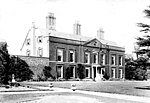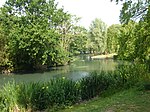Silver Street railway station
DfT Category D stationsEdmonton, LondonFormer Great Eastern Railway stationsLondon stations without latest usage statistics 1415London stations without latest usage statistics 1516 ... and 5 more
Rail transport stations in London fare zone 4Railway stations in Great Britain opened in 1872Railway stations in the London Borough of EnfieldRailway stations served by London OvergroundUse British English from August 2012

Silver Street is a London Overground station on the Lea Valley lines located in Edmonton in the London Borough of Enfield, north London. It is 7 miles 75 chains (12.8 km) down the line from London Liverpool Street and is situated between White Hart Lane and Edmonton Green. Its three-letter station code is SLV and it is in Travelcard zone 4.
Excerpt from the Wikipedia article Silver Street railway station (License: CC BY-SA 3.0, Authors, Images).Silver Street railway station
Sterling Way, London Edmonton (London Borough of Enfield)
Geographical coordinates (GPS) Address Nearby Places Show on map
Geographical coordinates (GPS)
| Latitude | Longitude |
|---|---|
| N 51.615 ° | E -0.067 ° |
Address
Silver Street Railway Station
Sterling Way
N18 2QH London, Edmonton (London Borough of Enfield)
England, United Kingdom
Open on Google Maps








